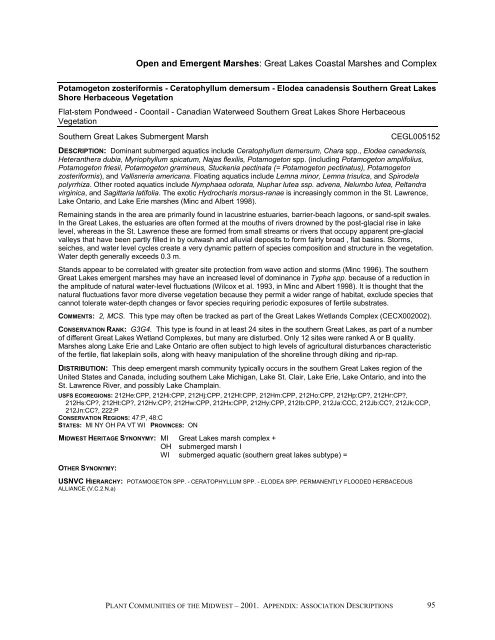Ohio subset of Plant Communities of the Midwest ... - NatureServe
Ohio subset of Plant Communities of the Midwest ... - NatureServe
Ohio subset of Plant Communities of the Midwest ... - NatureServe
You also want an ePaper? Increase the reach of your titles
YUMPU automatically turns print PDFs into web optimized ePapers that Google loves.
Open and Emergent Marshes: Great Lakes Coastal Marshes and Complex<br />
Potamogeton zosteriformis - Ceratophyllum demersum - Elodea canadensis Sou<strong>the</strong>rn Great Lakes<br />
Shore Herbaceous Vegetation<br />
Flat-stem Pondweed - Coontail - Canadian Waterweed Sou<strong>the</strong>rn Great Lakes Shore Herbaceous<br />
Vegetation<br />
Sou<strong>the</strong>rn Great Lakes Submergent Marsh<br />
CEGL005152<br />
DESCRIPTION: Dominant submerged aquatics include Ceratophyllum demersum, Chara spp., Elodea canadensis,<br />
Heteran<strong>the</strong>ra dubia, Myriophyllum spicatum, Najas flexilis, Potamogeton spp. (including Potamogeton amplifolius,<br />
Potamogeton friesii, Potamogeton gramineus, Stuckenia pectinata (= Potamogeton pectinatus), Potamogeton<br />
zosteriformis), and Vallisneria americana. Floating aquatics include Lemna minor, Lemna trisulca, and Spirodela<br />
polyrrhiza. O<strong>the</strong>r rooted aquatics include Nymphaea odorata, Nuphar lutea ssp. advena, Nelumbo lutea, Peltandra<br />
virginica, and Sagittaria latifolia. The exotic Hydrocharis morsus-ranae is increasingly common in <strong>the</strong> St. Lawrence,<br />
Lake Ontario, and Lake Erie marshes (Minc and Albert 1998).<br />
Remaining stands in <strong>the</strong> area are primarily found in lacustrine estuaries, barrier-beach lagoons, or sand-spit swales.<br />
In <strong>the</strong> Great Lakes, <strong>the</strong> estuaries are <strong>of</strong>ten formed at <strong>the</strong> mouths <strong>of</strong> rivers drowned by <strong>the</strong> post-glacial rise in lake<br />
level, whereas in <strong>the</strong> St. Lawrence <strong>the</strong>se are formed from small streams or rivers that occupy apparent pre-glacial<br />
valleys that have been partly filled in by outwash and alluvial deposits to form fairly broad , flat basins. Storms,<br />
seiches, and water level cycles create a very dynamic pattern <strong>of</strong> species composition and structure in <strong>the</strong> vegetation.<br />
Water depth generally exceeds 0.3 m.<br />
Stands appear to be correlated with greater site protection from wave action and storms (Minc 1996). The sou<strong>the</strong>rn<br />
Great Lakes emergent marshes may have an increased level <strong>of</strong> dominance in Typha spp. because <strong>of</strong> a reduction in<br />
<strong>the</strong> amplitude <strong>of</strong> natural water-level fluctuations (Wilcox et al. 1993, in Minc and Albert 1998). It is thought that <strong>the</strong><br />
natural fluctuations favor more diverse vegetation because <strong>the</strong>y permit a wider range <strong>of</strong> habitat, exclude species that<br />
cannot tolerate water-depth changes or favor species requiring periodic exposures <strong>of</strong> fertile substrates.<br />
COMMENTS: 2, MCS. This type may <strong>of</strong>ten be tracked as part <strong>of</strong> <strong>the</strong> Great Lakes Wetlands Complex (CECX002002).<br />
CONSERVATION RANK: G3G4. This type is found in at least 24 sites in <strong>the</strong> sou<strong>the</strong>rn Great Lakes, as part <strong>of</strong> a number<br />
<strong>of</strong> different Great Lakes Wetland Complexes, but many are disturbed. Only 12 sites were ranked A or B quality.<br />
Marshes along Lake Erie and Lake Ontario are <strong>of</strong>ten subject to high levels <strong>of</strong> agricultural disturbances characteristic<br />
<strong>of</strong> <strong>the</strong> fertile, flat lakeplain soils, along with heavy manipulation <strong>of</strong> <strong>the</strong> shoreline through diking and rip-rap.<br />
DISTRIBUTION: This deep emergent marsh community typically occurs in <strong>the</strong> sou<strong>the</strong>rn Great Lakes region <strong>of</strong> <strong>the</strong><br />
United States and Canada, including sou<strong>the</strong>rn Lake Michigan, Lake St. Clair, Lake Erie, Lake Ontario, and into <strong>the</strong><br />
St. Lawrence River, and possibly Lake Champlain.<br />
USFS ECOREGIONS: 212He:CPP, 212Hi:CPP, 212Hj:CPP, 212Hl:CPP, 212Hm:CPP, 212Ho:CPP, 212Hp:CP, 212Hr:CP,<br />
212Hs:CP, 212Ht:CP, 212Hv:CP, 212Hw:CPP, 212Hx:CPP, 212Hy:CPP, 212Ib:CPP, 212Ja:CCC, 212Jb:CC, 212Jk:CCP,<br />
212Jn:CC, 222:P<br />
CONSERVATION REGIONS: 47:P, 48:C<br />
STATES: MI NY OH PA VT WI PROVINCES: ON<br />
MIDWEST HERITAGE SYNONYMY: MI Great Lakes marsh complex +<br />
OH submerged marsh I<br />
WI submerged aquatic (sou<strong>the</strong>rn great lakes subtype) =<br />
OTHER SYNONYMY:<br />
USNVC HIERARCHY: POTAMOGETON SPP. - CERATOPHYLLUM SPP. - ELODEA SPP. PERMANENTLY FLOODED HERBACEOUS<br />
ALLIANCE (V.C.2.N.a)<br />
PLANT COMMUNITIES OF THE MIDWEST – 2001. APPENDIX: ASSOCIATION DESCRIPTIONS<br />
95
















